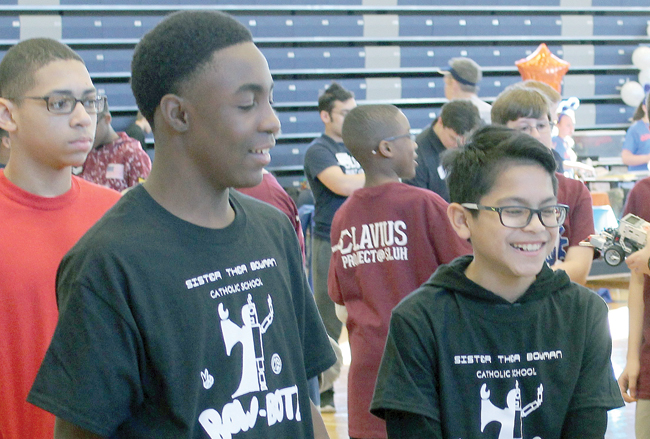By SUZANNE KOZIATEK
Contributing writer
In the Diocese of Belleville and across the country, Catholic schools are seeking to reach an underrepresented group of potential students by taking steps to recruit Hispanic families.
There were an estimated 12,500 Hispanic Catholics in the Diocese of Belleville in 2016, according to data collected as part of V Encuentro, an initiative of the U.S. Council of Catholic Bishops that seeks to meet the needs of Hispanic Catholics.
Catholic grade schools and high schools across the diocese enrolled 105 Hispanic students in 2016 – about 2.1 percent of the total Catholic school enrollment.
Ada Jimenez, family advocate for the diocesan Hispanic Ministry office, says the Hispanic Diocesan Plan was revised last year to focus more on recruitment and enrollment of Hispanic Catholic youth into parish schools.
“We have been encouraging principals to try to promote Catholic education within the Hispanic community, with mixed results,” she says.
One new tool to help promote Catholic education is the Empower Illinois program, which provides scholarships for private education for low-income families.
Jimenez says the diocese has been working to educate schools and parents about how to access the scholarship program.
But she says cost is only one barrier to greater Hispanic participation in Catholic education.
Language can be a significant obstacle, both for students and their parents. “If your parents’ principal language is Spanish, you already feel like an outsider,” Jimenez says.
She notes that Hispanic families don’t even necessarily speak Spanish fluently. “For a number of people, Spanish is their second language – they speak an indigenous language,” Jimenez says.
In addition, there is not a long tradition of Catholic education for all income groups in some Hispanic countries.
“In Mexico, most private schools are primarily something that rich kids go to,” Jimenez says.
In more rural parts of the diocese, the problem is compounded by a lack of nearby Catholic schools, says Sister Ellen Orf, CPPS, the diocese’s Hispanic minister for Clinton County.
And she notes that many families, newly arrived in the United States, are protective of their children, and are less likely to send them to a school where there are few or no other Hispanic students.
But it’s not an impossible task to boost Hispanic enrollment.
At Sister Thea Bowman Catholic School in East St. Louis, Principal Dan Nickerson is working to reach out to Hispanic families in nearby communities. He has about 15 Hispanic students out of a total enrollment of 130. Most are from St. Stephen Catholic Church in Caseyville, which has a Spanish language Mass.
Nickerson, who is married to Jimenez and lived for a time in Mexico, speaks Spanish, and works with children who struggle with English to help them improve their skills. “Even sounding out words is different in Spanish and in English – there’s only one sound per vowel in Spanish.”
He’s worked with the public school district to obtain testing in Spanish for children who are behind, so that teachers can determine how much of the problem is cognitive and how much is language-related.
And he communicates with parents in Spanish, having newsletters translated to send to them.
Over time, he says, he’s seen students go from quiet and reserved to outgoing and fully participating, as their language skills improve.
He finds Hispanic families in his school to be highly respectful of teachers and administrators and eager to volunteer to help out.
The atmosphere at Sister Thea Bowman, with its large African-American population, may be an advantage, he says.
“In some schools, if you’re a Hispanic family, you might stick out,” he says. “Here, they come in and they’re a minority amongst a minority. Nobody really pays attention to it.”
He’s been working with families to help them get tuition assistance. He’s also introduced them to the Empower Illinois scholarship program, but so far that hasn’t been a major factor in recruitment, mostly because of lack of available funding. “We’re hoping as it gains momentum, it will provide more assistance.”
Maria Magaña and her husband Jose Vega have two children currently attending Althoff Catholic High School. Alicia, 16, is a rising junior, and Alex, 15, will be a sophomore next year.
Both previously attended Sister Thea Bowman.
Magaña says she and her husband were drawn to Catholic schools after their son encountered problems with other students in public school.
“We were looking for a safe place for our kids,” she says. “And we wanted them to be believers.”
She says many Hispanic families worry that Catholic education will be too expensive, but tuition assistance has helped her family afford both schools. And Magaña and her husband were willing to make sacrifices for their children’s schooling.
“Education is the most important goal for my husband and I,” she says. She tells her friends about ways to help make it more affordable, such as tax deductions for private school tuition.
Magaña says her friends have remarked upon the positive change in her children since they’ve been in Catholic school. She’s noticed it as well.
“My husband and I feel happy about making this choice,” she says.







